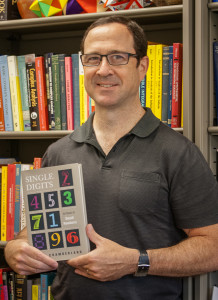SUSANNE BUSHMAN, Arts Editor
bushmans@grinnell.edu
Polling booths, pizza and playing cards find common ground in a new book by Professor Marc Chamberland, Math & Statistics, entitled “Single Digits: In Praise of Small Numbers.”
Chamberland read from his book this Wednesday night at Prairie Lights Books in Iowa City. Each chapter of the book tackles a respective single digit from one through nine and demonstrates interesting math facts and information around that number, such as the way that ranking candidates can drastically change the outcome of an election.
Some parts of the book are very accessible to most people, while others are more complicated. Overall, however, Chamberland hopes the book will get people to see a side of math that is more interesting than the required high school math curriculum.
“I’ve been interested in popularizing math for a long time,” Chamberland said. “That’s a big part of my motivation for doing a project like this … For a lot of people math has left a bad taste in their mouth so they think math is just all these complicated tools … But a lot of [math classes], especially the way they’re taught, is really just involving tools and you’re not actually getting to the really interesting ideas.”
Chamberland compared teaching high school math to teaching someone who wanted to be a chef only about how to use various cooking tools, without ever using them to make and eat food.
Chamberland also uses his YouTube channel, “Tipping Point Math,” to show the more interesting side of math and shared several of his videos during his reading at Prairie Lights.
The unique topic of the book lead to a more unconventional reading where Chamberland showed figures and explained equations and theorems rather than simply reading aloud passages from his book.
This topic developed for Chamberland as a high number of facts accumulated naturally, particularly surrounding the single digits.
“When I come across what I think are interesting facts or pieces of information, I’ve gotten into the habit over a number of years [of writing] it down somewhere in an organized way. And I started noticing a pattern,” Chamberland said. “I saw … a growing body of information [around single digits] that could be really interesting. … Then, instead of just waiting for things to come along that I might encounter either because of my research interest or my teaching I thought, ‘Let me start looking for stuff.’”
This search lead to what Publisher’s Weekly hailed as “[a] wonderful book [that] never loses its focus or momentum.”




















































